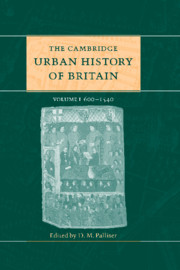Book contents
- Frontmatter
- Part I Introductory
- Part II The early middle ages 600–1300
- Part III The later middle ages 1300–1540
- 12 General survey 1300–1540
- 13 Government, power and authority 1300–1540
- 14 The economy of British towns 1300–1540
- 15 Urban culture and the Church 1300–1540
- 16 The built environment 1300–1540
- 17 London 1300–1540
- 18 The greater towns 1300–1540
- 19 Port towns
- (a) England and Wales 1300–1540
- (b) Scotland 1300–1540
- 20 Small towns 1270–1540
- Part IV Regional surveys
- Part V Conclusion
- Appendix: Ranking lists of English medieval towns
- Select bibliography
- Index
- References
(b) - Scotland 1300–1540
from 19 - Port towns
Published online by Cambridge University Press: 28 March 2008
- Frontmatter
- Part I Introductory
- Part II The early middle ages 600–1300
- Part III The later middle ages 1300–1540
- 12 General survey 1300–1540
- 13 Government, power and authority 1300–1540
- 14 The economy of British towns 1300–1540
- 15 Urban culture and the Church 1300–1540
- 16 The built environment 1300–1540
- 17 London 1300–1540
- 18 The greater towns 1300–1540
- 19 Port towns
- (a) England and Wales 1300–1540
- (b) Scotland 1300–1540
- 20 Small towns 1270–1540
- Part IV Regional surveys
- Part V Conclusion
- Appendix: Ranking lists of English medieval towns
- Select bibliography
- Index
- References
Summary
In Scotland, as in England, ports were the kingdom's gateway to Christendom. Few of medieval Scotland's towns were, however, natural ports. Of fifty-five established burghs by 1300, twenty-three were located on inland sites. Although eleven others were on navigable rivers, most of these arguably owed their origins less to maritime access than to land routes which converged on estuarine fording points. Of the twenty-one coastal burghs many, such as Cromarty and Cullen, were of such minimal economic significance that they can be scarcely classified as either ports or towns. Even among those which did develop a regular maritime trade, the topography of some suggests that maritime access was of secondary significance to their early development. Although, for instance, noted in the early twelfth century as one of only three trading centres north of Forth, it remains uncertain whether Inverkeithing developed around the natural harbour at the mouth of the Keithing burn or around the main thoroughfare which was located on considerably higher ground to the north. A similar observation has been made of Crail and could be made of Montrose, where the distinctive place name of the harbour, Strumnay, suggests a separate origin from that of the adjacent town.
There were few exceptions to the predominantly landward vista of the early Scottish burghs. Aberdeen was probably one, particularly if the plausible identification of its early nucleus as adjacent to the Denburn harbour is accepted. Dundee and Ayr were probably others. These coastal towns were well positioned to exploit the commercial expansion of the twelfth and thirteenth centuries, an expansion spawned chiefly by a new Anglo-Norman elite demanding the importation of wine and wheat and the more or less simultaneous emergence of large quantities of wool available for export to the Netherlandish draperies.
- Type
- Chapter
- Information
- The Cambridge Urban History of Britain , pp. 495 - 504Publisher: Cambridge University PressPrint publication year: 2000



